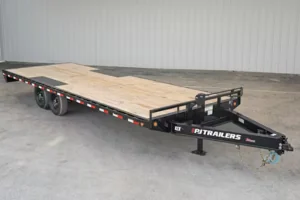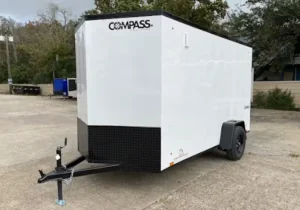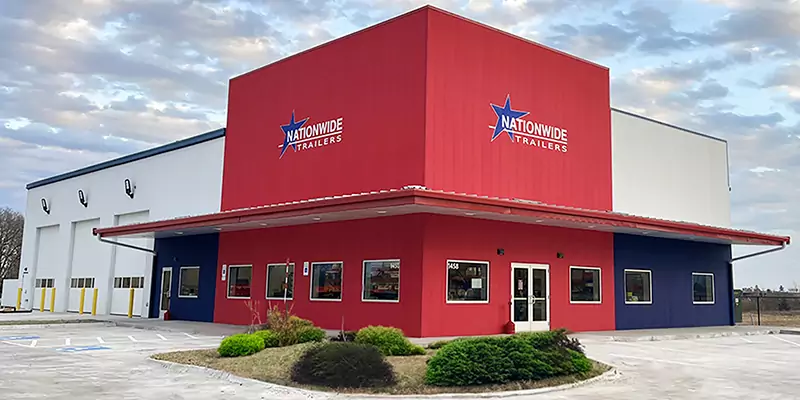Gooseneck vs. Bumper Pull Trailers
When you have livestock, materials or equipment to haul, finding the right trailer is key. One of the biggest debates in the trailer world is gooseneck versus bumper pull. These two trailer types can both hitch to a pickup truck and can be found just about anywhere, but is one better than the other? Before you decide on which trailer is best, you should understand the benefits and disadvantages of both. From there, you can make an informed decision based on your hauling needs.
What’s the Difference Between Bumper Pull and Gooseneck Trailers?

The difference between a bumper pull trailer and a gooseneck is how they connect to a tow vehicle.
The bumper pull trailer is one of the most standard hitches out there. Also known as drag trailers, bumper trailers connect to the ball hitch on a tow vehicle’s rear frame. These trailers have a tongue with a rounded pocket that fits perfectly onto a standard ball hitch. This type of hitch is extremely common, so bumper pull trailers can be used with many popular vehicles.
A gooseneck trailer is named for its shape. The connecting piece has a large arch shape resembling the neck of a goose, giving this design a wildly different look compared to the low-set tongue piece on a bumper pull trailer. Gooseneck trailers need to be anchored through the bed of a pickup truck with the help of frame rails. These metal pieces are attached to the truck’s frame and stretch across the width of its flatbed. The center of this frame has a gooseneck hitch ball that protrudes through the truck bed and provides the connection point for the trailer.
The design differences between gooseneck and bumper pull trailers mean there are big differences to consider when shopping for a new hauler.
Size
While it’s not a rule, you can usually expect gooseneck trailers to come in larger sizes than bumper pull trailers. A gooseneck trailer will overlap with a truck’s bed. This positioning over the tow vehicle’s rear axle disperses pressure more evenly across the frame. The science behind a gooseneck trailer means it can safely handle more weight.
Bumper pull trailers, in contrast, don’t benefit from this improved load dispersion, so they tend to have lower weight capacities.
Towing Capacity
Bumper pull trailers are often smaller than their gooseneck counterparts, another factor that typically translates to a lower towing capacity. This lower capacity makes the bumper pull design ideal for personal hauling needs, but these models might not have the capacity needed for larger-scale commercial hauling. Gooseneck is often the choice for those applications.
Price Range
Generally, a bumper pull trailer will cost less than a gooseneck. Since bumper pull trailers are smaller and lighter, less material and money are needed to manufacture them. The lower cost also makes these trailers more accessible to people with minimal hauling needs. Gooseneck trailers, on the other hand, are larger, which typically drives up the costs.
The Benefits of a Bumper Pull Trailer
The primary advantages of bumper pull trailers are:
- Vehicle compatibility: Ball hitches are common on many vehicle types, from all sizes of pickup trucks to SUVs and crossovers. This compatibility with many types of tow vehicles makes bumper pull models excellent for a range of applications.
- Cost: The lower cost of bumper pull trailers makes them more accessible to the average person. People might use these trailers to take their four-wheelers to their cabins or transport materials for a carpentry project. Businesses like landscape companies often use these trailers for small pieces of equipment. The lower price tag makes them a great option for people and operations with tighter budgets.
- Normal turn radius: Thanks to the attachment method of a bumper pull trailer, they have a normal turn radius. When you’re driving your tow vehicle, the trailer will follow with the exact same arc. This design makes it easier for beginners to haul a trailer with their trucks or SUVs.
- Hitch options: While the ball hitch is the more common hitch type of a bumper pull trailer, you also have the option to use the pintle or lunette eye hitch. This type of hitch can increase the towing capacity of the bumper pull design, so it’s often used for larger trailers.
The Disadvantages of a Bumper Pull Trailer
The biggest disadvantages of bumper pull trailers are:
- Size limitations: The ball hitch attachment can only bear so much weight, so the bumper pull trailer is not the best choice for large hauling applications. Whether you’re moving a lot of heavy equipment or livestock, you might be better off with a high-capacity gooseneck trailer.
- Weight distribution requirements: Bumper pull trailers are more susceptible to sway, which can be dangerous on the road. Sway is particularly common when your fully loaded trailer represents half or more of the weight of your tow vehicle. In these cases, you’ll need a weight distribution setup to reduce the sway risk.
- Normal turn radius: While a drag trailer’s normal turn radius can be a benefit for beginners, it’s also a disadvantage. A wider turn radius can make it harder to maneuver your trailer into tighter spaces and parking spots.
- Challenging to hook up: When you’re hooking up a bumper pull trailer, you might need help from another person, as the ball hitch at the base of your vehicle’s bumper won’t be visible from the driver’s seat as you back up. If you try to hook up your trailer alone, it might take a little extra time to get it right.
The Benefits of a Gooseneck Trailer
Gooseneck trailers can be a great choice for several reasons, including:
- High load capacity: Gooseneck trailers offer excellent stability, so they can carry large loads. When you have major hauling needs, gooseneck trailers are the way to go. The higher load capacity is a big reason why gooseneck trailers are the preferred choice for commercial applications.
- Sharp turn radius: The hitch style of a gooseneck trailer gives it more space to make sharp turns. This improved turn radius makes the trailer more maneuverable despite its size, simplifying fitting into awkward spaces and backing into parking spots.
- No sway risk: With its extra stability and overlap with a truck’s flatbed, gooseneck trailers do not have a swaying risk like bumper pull trailers. This fact means two things — your trailer is safer on the road, and weight distribution is much less of a concern.
- Easy to hook up: Gooseneck trailers hitch to a system in your truck’s bed, making the ball visible from the driver’s seat. As you’re backing up to your trailer, you can easily see how to line up your hitch — no extra person required.
The Disadvantages of a Gooseneck Trailer
Some of the challenges you might face with a gooseneck trailer include:
- Vehicle limitations: Gooseneck trailers can only be used with pickup trucks because you need the hitch mechanism locked across the bed. If your only available tow vehicle is an SUV, crossover or cargo van, you need a bumper pull trailer.
- Storage needs: Since gooseneck trailers are generally larger, you’re going to need more space to store them. For bigger commercial operations, this might not be a major problem, but smaller businesses might need to consider the additional expenses for larger storage. It’s also important to note that these trailers may be larger than the standard parking space.
- Higher cost: A new gooseneck trailer will cost you more than a bumper pull trailer, so you’ll need to be prepared for that expense. The benefits of these trailers may help to offset the expense over time. You can also look into used models if needed.
- Steep learning curve: The sharper turn radius of a gooseneck trailer is great for maneuverability, but it can be challenging to get used to. If you’re new to hauling, it may take some practice to acclimate to the way a gooseneck trailer follows behind your truck.
Is a Gooseneck Better Than a Bumper Pull?
Whether or not a gooseneck trailer is better than a bumper pull will depend on what you need it for. Both types are reliable for hauling and can make your life easier when it comes to moving large loads from point A to point B. When you’re ready to buy a trailer, you should consider your priorities to determine which trailer is the best choice.
For example, a business that has high-capacity hauling needs every day will have better luck with a gooseneck. On the other hand, a hobby woodworker who needs to haul materials for projects will probably turn to the bumper pull to save some money. Think about what’s most important to you to find the right trailer for your hauling requirements.

Find Gooseneck and Bumper Pull Trailers at Nationwide Trailers
Nationwide Trailers is your source for all types of trailers, from gooseneck and bumper pull styles to more specialized models like race trailers and concession trailers. We have what you need across multiple locations in Texas, Oklahoma, Arkansas and Missouri. Browse our inventory today and call or text your nearest location for more information.




